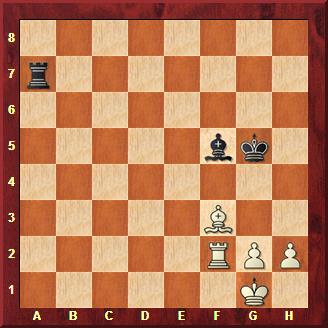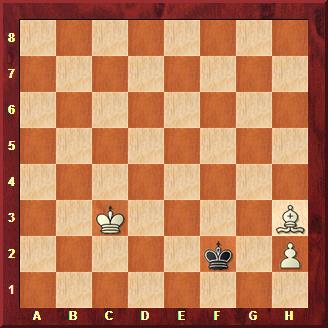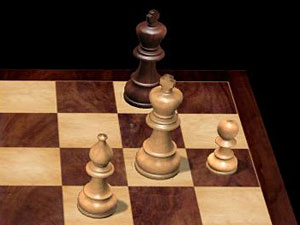The wrong bishop
By Frederic Friedel
This article draws from a puzzle section which we started a decade and a half ago, but which was lost when we switched to a new content management system and news database. For older readers the cherries we will pick out of the original section will hopefully bring on nostalgic memories, while younger readers will learn for the first time what we have been up to over the years. And remember: there are 15-year-old grandmasters who were not born when articles in our puzzle section first appeared.
The endgame bishop and pawn against a lone king is generally won, even if the bishop doesn't control the queening square of the pawn. A tempo move or two will dislodge the defending king and the promotion is inevitable. However there is one important exception. This is when the pawn is on the edge of the board and the bishop does not control the promotion square. Here's an example: in the following position White cannot win. The black king simple shuffles between the squares g8 and h8 (or between h8 and g7) and cannot be dislodged, only stalemated.

[Event "Theoretical draw"] [Site "?"] [Date "2016.05.13"] [Round "?"] [White "The wrong bishop (1)"] [Black "White to play"] [Result "1/2-1/2"] [SetUp "1"] [FEN "6k1/8/6KP/5B2/8/8/8/8 w - - 0 1"] [PlyCount "7"] [SourceDate "2016.05.13"] 1. Kh5 (1. Be6+ Kh8 2. h7 {is stalemate.}) 1... Kh8 ({Black must commit a dreadful blunder in order to lose:} 1... Kf8 $4 2. Bh7 Kf7 3. Kg5 Ke7 4. Kg6 Kf8 5. Kf6 {and White will queen the pawn.}) 2. h7 Kg7 3. Bc2 Kh8 4. Kh6 { is stalemate.} 1/2-1/2
This ending with the "wrong coloured bishop" has been know to chess players for a long time. Here's a study from the 17th century:
Gioacchino Greco, Le Iev des Eschets 1621

Black to play and draw
At first sight it looks incredible that Black can draw this position – after all his opponent has two connected passed pawns. But it can be done, with a few sharp strokes. Try to figure it out for yourself before you peek at the solution.

[Event "Le Iev des Eschets 1621"] [Site "?"] [Date "????.??.??"] [Round "?"] [White "Gioacchino Greco"] [Black "Black to play and draw"] [Result "1/2-1/2"] [SetUp "1"] [FEN "8/r7/8/5bk1/8/5B2/5RPP/6K1 b - - 0 1"] [PlyCount "6"] 1... Ra1+ 2. Rf1 Rxf1+ $1 3. Kxf1 Bh3 $3 4. gxh3 {and the position is a theoretical wrong bishop draw, even though White has two pawns on the h-file.} ({Naturally} 4. Kf2 {will not help, since Black simply plays} Bxg2 $1 {with the same draw to follow.}) 1/2-1/2
The rule of the wrong bishop draw is simple. The endgame king, bishop and pawn vs king is always a draw when
- the pawn is on the a or h-file and the bishop does not control the promotion square;
- the defending king can reach the promotion square in time to defend it.
For a long time this simple piece of chess knowledge eluded chess playing computers. They simply couldn't calculate all the way to the promotion, and without specific instructions on how to handle the position they would often take a wrong decision. During the 1980s, when the first programs were being told about the wrong bishop draw, I devised a test position to find out if they could handle the endgame correctly.

[Event "Theoretical draw"] [Site "?"] [Date "2016.05.13"] [Round "?"] [White "The wrong bishop - test"] [Black "White to play"] [Result "1/2-1/2"] [SetUp "1"] [FEN "k7/7p/8/2nKb3/8/8/8/8 w - - 0 1"] [PlyCount "11"] [SourceDate "2016.05.13"] {As an astute chess player you will immediately know what to do:} 1. Kxc5 $1 ({ But for the computers at the time it was too difficult. They would inevitably take the bishop and lose the game, e.g.} 1. Kxe5 $4 h5 2. Kf4 Ne6+ 3. Kg3 Kb7 4. Kh4 Ng7 {and Black wins.}) 1... h5 2. Kd5 h4 3. Ke4 h3 4. Kf3 h2 5. Kg2 Kb7 6. Kh1 {theoretical draw.} 1/2-1/2
The temptation for early day computers was simply too great. They went astray for the following reasons:
- a bishop is valued higher than a knight, especially in open endgame positions;
- Kxe5 centralises the king, while Kxc5 doesn't
- if it takes the knight the black pawn advances all the way to h2, where it gets a lot of bonus points for being one square away from promotion. After taking the bishop it can be kept on the top half of the board.
So any sensible computer would take the bishop, unless of course it was told to do otherwise. Which seemed to be the case in the following game.

[Event "Mississippi State Championship"] [Site "?"] [Date "1982.??.??"] [Round "?"] [White "Human"] [Black "Cray Blitz"] [Result "0-1"] [WhiteElo "2265"] [SetUp "1"] [FEN "R7/p4r2/1p2b3/4k3/P7/4KB2/8/8 b - - 0 1"] [PlyCount "17"] [SourceDate "2016.05.13"] {Naturally the computer immediately saw the trick and played} 1... Rxf3+ $1 2. Kxf3 Bd5+ 3. Ke3 Bxa8 {With a piece and a pawn down the human player was reduced to trying a swindle:} 4. a5 $6 {Could it work, would the program take the free pawn offer? Nope, Cray Blitz avoided the pitfall and played} Be4 $1 { winning the game comfortably after} (4... bxa5 $4 5. Kd3 Bd5 6. Kc3 Ba2 7. Kb2 Be6 8. Ka1 {with the theoretical wrong bishop draw.}) 5. Kd2 Kd4 6. Kc1 b5 7. Kb2 Kc4 8. a6 b4 9. Ka2 Kc3 {with a mate announcement in six.} 0-1
At the time this was celebrated as the first instance of practical chess knowledge, implemented into a computer, leading to a victory when otherwise a draw would be expected. But some time later I obtained the computer logs and discussed the position with Harry Nelson of the Cray team. It turned out that Cray Blitz had simply searched deep enough to see the promotion after 4...Be4, while it found no queen on the board after 4...bxa5. It was that simple.
A decade later all top programs knew about the wrong bishop ending and could solve each of the above endings instantly. For instance here is Fritz 8 avoiding the temptation after 4.a5?! in the above Cray Blitz position:

Not for a single cycle did the program consider 4...bxa5, but immediately went for 4...Be4 and tried to work out just how many pawns that was worth (17, it turns out). Our test position above was solved in 0:00:00 seconds (1.Kxc5!), as was the Greco study, as you can see in the picture below.

A test for humans
The following study was shown to me around 1982 by GM Klaus Darga (we did not have an author at the time). In the meantime I have found three different sources, the one given below being the oldest.
J. Vancura, Ceske Slovo 1922

White to play and win
After the above lecture on wrong bishops you will know exactly what this study is about. Please try to solve it yourself – and keep a record of the time you require to find the one correct move in the above position (all others lead to a draw). In a few days we will tell you how some famous players fared with this problem, and you can compare your solving time with theirs. We will also give you a few more problems to hone your skills in this useful theoretical endgame.




























